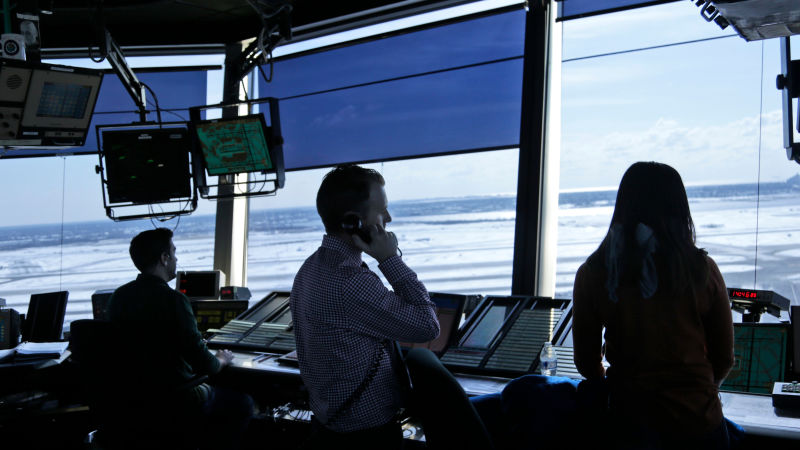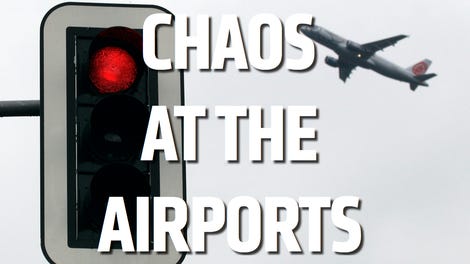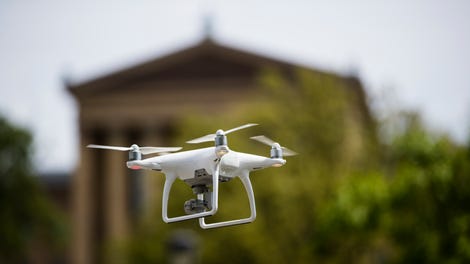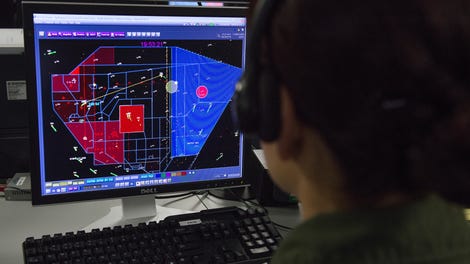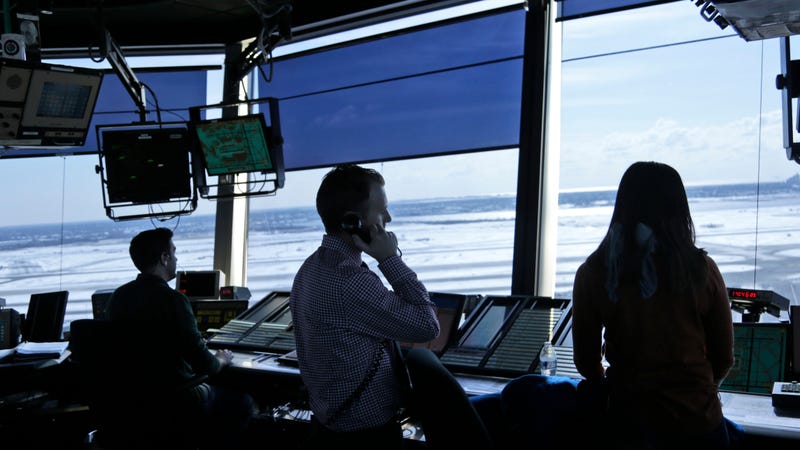
President Donald Trump announced a plan today to privatize the U.S. air traffic control system, saying it “will you get you where you need to go more quickly.” Sounds great. But—surprise—the issue’s not as cut and dried as the president would make it out to be. Here’s what’s going on.
What Trump Wants To Do
If you have a pulse and previously spent more than a few moments in an airport, you know traveling by plane can be a nightmarish experience, the recent ghastly incidents with United Airlines notwithstanding. Trump claims the problems are due in part to our air traffic controller system, which he described in typical Trumpian fashion as “horrible,” “antiquated,” “ancient” and a “total waste of money.”
To resolve what the president and major airlines see as the problem, what is being proposed is a total shake-up of the air traffic control system as we know it.
Advertisement
Advertisement
Instead of the responsibility falling to the government, a new, private, nonprofit corporation run by airlines and aviation interests would run the nation’s 300 airport towers and flight tracking centers. The new entity’s board would reportedly contain 13 members, with eight appointed by Trump’s transportation secretary, Elaine Chao, an advocate of the plan, meaning it would be dominated by major airline and general aviation interests.
Trump noted that the air traffic control union supports the issue, and airlines have supported the idea since the 1980s. It would entail replacing passenger ticket taxes with user fees on takeoffs and landings, the Associated Press reports.
Former President Bill Clinton’s administration pushed the idea in the 1990s, but Congress spiked it; last year, Republican U.S. Rep. Bill Shuster proposed a privatization bill, but failed to win support of his colleagues. The Associated Press notes that Shuster’s bill is seen by some of Trump’s transportation officials as a potential vehicle to enact the president’s plan.
Sponsored
In short, it would represent one of the largest transfers of a government asset in U.S. history—taxpayers have spent north of $53 billion on these facilities in the last two decades—affecting an estimated 35,000 workers, according to the AP.
It’d also play into daily flights for all of us. Airports in the U.S. handle an estimated 50,000 flights per day and carry 700 million passengers in a year.
Chao is expected to address a U.S. House panel on Thursday about the proposal.
Airlines Suck, So Why Would I Want Them In Charge?
Good question.
Advertisement
Smaller players in the industry have criticized the plan in the past for relegating so much power to the major airlines, and the nonpartisan U.S. Government Accountability Office previously said as much that the arrangement poses a possible unseemly circumstance.
“In addition, another concern raised by experts during our interviews is that small and rural communities could be negatively affected by a restructured ATC,” the GAO wrote in a 2016 report. “According to one expert whom we spoke to, rules need to be in place for the ATC entity to not restrict access so that only high value customers, such as commercial airlines are served; access should be maintained for small communities and other services, which are important but don’t make a lot of money.”
The GAO also pointed out that Trump’s proposed private ATC system would gave it unlimited “leeway regarding its user fee structure,” but it struck an optimistic note, saying, “an oversight board made up of stakeholders—such as commercial air carriers, business and general aviation, government officials, and unions … might not require economic regulation because the board’s membership has a vested interest in keeping rates at appropriate, cost-based levels.” (The operative word to stress there is might.)
Advertisement
From a national security standpoint, the U.S. Department of Defense’s aviation policy board, for example, told Aviation International News earlier this year that it poses a number of potential problems.
FAA air route traffic control centers that manage high-altitude airspace delegate authority to DOD controllers for operations in special use airspace and in terminal areas surrounding military airfields. “DOD and FAA air traffic controllers interface to effect arrival, departure and enroute coordination and transfer of control from one facility to another on a real-time basis,” the board said. “DOD controllers provide service to any aircraft that transits their assigned airspace. There are numerous examples where DOD controllers provide services into/out of civilian/commercial airports.”
While DOD military or civilian controllers typically staff the ATC towers at military airfields, “there are unique examples where DOD control towers are staffed by FAA civilian controllers,” the board said, citing Joint Base Andrews in Maryland and Joint Base Pearl Harbor-Hickam in Hawaii as examples.
Is Air Traffic Control Really The Reason For Delays?
Trump framed the proposal as representative of a “great new era in American innovation.” And a new site rolled out to boost his administration’s proposal touted that it would “provide more direct flights, shorter routes, and fewer delays and cancellations.”
“We’re proposing to take American air travel into the future, finally,” he said on Monday.
Advertisement
Advertisement
But the truth is that crummy routing by air traffic controllers isn’t behind the uptick in flight delay problems across the industry. As Bloomberg noted last fall, the issue belongs to the airlines themselves. Computer glitches, mechanical breakdowns and a shortage of flight crew members led airlines to assume the No. 1 position in delays, in what Bloomberg said was the “widest margin” since data was first collected by the government about 15 years ago.
Would A Private Entity Improve Operations?
The nonpartisan Congressional Research Service issued a report on proposed ideas for revamping the air traffic control system, and said there’s a limited amount of research behind the issue.
One report the CRS cited from 2009 found privatized entities from across the world have improved air service qualities “in most cases,” as they didn’t have “to compete for funds with other government projects.” Still, the purported benefits of a privatized system aren’t exactly a surefire thing.
Advertisement
“There does not appear to be conclusive evidence that any of these models is either superior or inferior to others or to existing government-run air traffic services, including FAA, with respect to productivity, cost-effectiveness, service quality, and safety and security,” the CRS wrote.
The closet example to what Trump proposes to do can be found in Canada, which privatized its system in 1996 and handles an estimated one-tenth of the traffic overseen by the FAA. The CRS says the creation of the entity, NAV CANADA, has appeared to help maintain stable rates, but—according to the GAO—it has presented difficulties elsewhere; for one thing, the private entity siphoned a stream of skilled staff that left Canada’s safety regulator unable to fill key jobs.
And despite the arrangement, the CRS cited one survey from 2006 that showed “perceptions of service quality and satisfaction with the delivery of air traffic services were found to be better among U.S. pilots reporting on FAA performance compared to Canadian pilots reporting on their experiences with NAV CANADA.”
Isn’t There Already A Plan To Improve The System?
Back in 2003, the Federal Aviation System rolled out a plan to ostensibly modernize the air traffic controller system called NextGen. By all accounts, the process has been clunky and slow. It’s a perfect foil for privatization advocates.
Advertisement
Advertisement
“The stop and go approach of the annual appropriations process with the political overlay and sequester is not conducive to responsible long-term planning,” the Trump administration’s website says of NextGen. “A large, complex federal government agency and an unpredictable appropriations process will, at best, only deliver sporadic and incremental change.”
What’s The Upshot?
What Trump’s proposing is something that has been kicked around since the 1970s, and it’d be a pinnacle achievement for privatization-giddy folks like Shuster and the major airlines. It’d also be a massive undertaking for the U.S., and one that couldn’t be smoothly delivered by a bunch of klutzes.
While this could boil down to a he-said-she-said slapfight, there’s an innumerable amount of variables at play that need to be hashed out in order for the airline industry to not become even more fucked up. Can the administration be expected to deliver something so seamless?
Advertisement
And given that the majority of flight hiccups can be attributed to the major airlines themselves, you have to wonder what’s behind the push now. Trump reportedly has cited his own personal pilot’s lamentations as reason for his support of privatization—and with him known to accept at face value whatever someone says to him, maybe that’s the driving force here.
But airlines have a tendency to treat consumers like garbage. So the question is whether lawmakers are going to be convinced, at this moment, that it’s best to hand more control of the aviation industry over to them.

